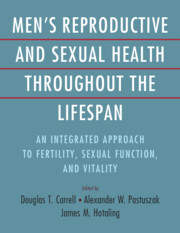 Men's Reproductive and Sexual Health Throughout the Lifespan
Men's Reproductive and Sexual Health Throughout the Lifespan Book contents
- Men’s Reproductive and Sexual Health throughout the Lifespan
- Men’s Reproductive and Sexual Health throughout the Lifespan
- Copyright page
- Contents
- Contributors
- Preface
- Section 1 An Introduction to Men’s Health Care
- Section 2 The Biology of Male Reproduction and Infertility
- Chapter 4 Current Understanding of the Physiology and Histology of Human Spermatogenesis
- Chapter 5 Male Reproductive Endocrinology
- Chapter 6 Sperm Chromatin Packaging and the Toroid Linker Model
- Chapter 7 Ejaculation and Sperm Transport
- Chapter 8 Genetic Aspects of Male Infertility
- Chapter 9 The Mechanistic and Predictive Utility of Sperm Epigenetics
- Chapter 10 Aging and Environmental Interactions with the Sperm Epigenome
- Chapter 11 The Effects of Aging on Male Fertility and the Health of Offspring
- Section 3 Clinical Evaluation and Treatment of Male Infertility
- Section 4 Laboratory Evaluation and Treatment of Male Infertility
- Section 5 Medical and Surgical Management of Issues of Male Health
- Index
- References
Chapter 11 - The Effects of Aging on Male Fertility and the Health of Offspring
from Section 2 - The Biology of Male Reproduction and Infertility
Published online by Cambridge University Press: 06 December 2023
- Men’s Reproductive and Sexual Health throughout the Lifespan
- Men’s Reproductive and Sexual Health throughout the Lifespan
- Copyright page
- Contents
- Contributors
- Preface
- Section 1 An Introduction to Men’s Health Care
- Section 2 The Biology of Male Reproduction and Infertility
- Chapter 4 Current Understanding of the Physiology and Histology of Human Spermatogenesis
- Chapter 5 Male Reproductive Endocrinology
- Chapter 6 Sperm Chromatin Packaging and the Toroid Linker Model
- Chapter 7 Ejaculation and Sperm Transport
- Chapter 8 Genetic Aspects of Male Infertility
- Chapter 9 The Mechanistic and Predictive Utility of Sperm Epigenetics
- Chapter 10 Aging and Environmental Interactions with the Sperm Epigenome
- Chapter 11 The Effects of Aging on Male Fertility and the Health of Offspring
- Section 3 Clinical Evaluation and Treatment of Male Infertility
- Section 4 Laboratory Evaluation and Treatment of Male Infertility
- Section 5 Medical and Surgical Management of Issues of Male Health
- Index
- References
Summary
Paternal age is increasing with time. Increasing evidence suggests that a man’s reproductive health changes with age. A man’s fertility may decline as he ages with evidence of an association with unassisted and assisted conception. In addition, there are risks to the pregnancy and child for older fathers. While the definition of advanced paternal age remains uncertain, the consequences of paternal age are becoming more quantifiable.
- Type
- Chapter
- Information
- Men's Reproductive and Sexual Health Throughout the LifespanAn Integrated Approach to Fertility, Sexual Function, and Vitality, pp. 87 - 96Publisher: Cambridge University PressPrint publication year: 2023


